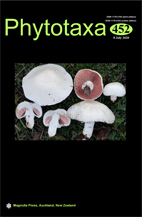Abstract
A new wood-decaying fungus, Xylobolus austrosinensis, is described and illustrated from southern China based on morphological and molecular evidence. It is characterized by the thick and pulvinate basidiomata, numerous acanthocystidia, acanthoid basidia, and ovoid to subglobose basidiospores (4–4.5 × 2.8–3.5 µm). The new species is similar to X. frustulatus, but differs in having acanthoid basidia, rounder basidiospores and a subtropical-tropical distribution. In the phylogenetic tree inferred from ITS sequence data of Stereaceae, five species of Xylobolus, including the new species, formed a clade with relatively strong supports. Xylobolus spectabilis and X. illudens are excluded from the genus based on our analyses. Xylobolus ahmadii, X. brasiliensis and X. peculiare are not accepted in the genus according to their morphological descriptions and unpublished sequence data. Xylobolus gongylodes that was not included in the phylogenetic analyses is temporarily accepted in the genus. An identification key to all six accepted species of Xylobolus is provided.

